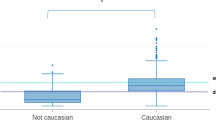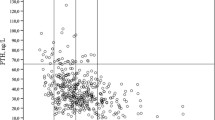Abstract:
The first part of this study consisted of an 18 month follow-up of the vitamin D status and parathyroid function in a group of 54 French male adolescents, aged from 13 to 16 years old and all pupils of a jockey training school. During the 18 month period four samplings were made, one every 6 months. The first was during September of the first year, the second and third during March and October of the second year, and the last in March of the third year. Therefore we had two main periods: summer and winter. The summer 25-hydroxyvitamin D (25(OH)D) concentrations were higher (71.6 ± 19.9 and 52.4 ± 16.5 nmol/l) than the winter ones (20.4 ± 6.9 and 21.4 ± 6.1 nmol/l). Conversely, the winter intact parathyroid hormone (iPTH) serum levels (4.18 ± 1.18 and 4.11 ± 1.35 pmol/l) were higher than the summer ones (2.44 ± 0.82 and 2.71 ± 0.71 pmol/l). At the two winter time points the 25(OH)D concentrations were lower than 25 nmol/l (10 ng/ml) in 72% (2nd year) and 68% (3rd year) of the adolescents. In the second part of the study we tried a vitamin D3 supplementation procedure designed to maintain the 25(OH)D and iPTH postsummer serum levels throughout the winter. Pairs of male adolescents matched for height, weight and Tanner pubertal stage were randomly assigned to either vitamin D3 supplementation (2.5 mg, i.e., 100 000 IU) administered orally at three specific periods (end of September, November and January) or no vitamin D3 treatment (control subjects). Blood was collected just before the first intake of vitamin D3 and 2 months after the last intake (March). The control subjects had blood drawn at the same time points. In the vitamin D3-treated subjects, the concentrations of 25 (OH)D (55.3 ± 11.5 nmol/l) and of iPTH (3.09 ± 1.16 pmol/l) in March and September (53.8 ± 12.3 nmol/l and 2.75 ± 1.26 pmol/l) were not significantly different. In the control subjects, March 25(OH)D levels (21.0 ± nmol/l were low, with values below 25 nmol/l in 78% of subjects, and iPTH concentrations (3.97 ± 1.08 pmol/l) were significantly (p<0.001) higher than in September (2.91 ± 0.81 pmol/l). The constant vitamin D wintertime deficiency and wintertime rise in iPTH in adolescent French males throughout puberty has been demonstrated. In adolescents with low dairy calcium intakes, the vitamin D3 treatment was sufficient to maintain 25(OH)D concentrations at their summer levels throughout winter and to prevent an excessive wintertime rise in iPTH levels.
Similar content being viewed by others
Author information
Authors and Affiliations
Additional information
Received: 6 February 2001 / Accepted: 9 May 2001
Rights and permissions
About this article
Cite this article
Guillemant, J., Le, HT., Maria, A. et al. Wintertime Vitamin D Deficiency in Male Adolescents: Effect on Parathyroid Function and Response to Vitamin D3 Supplements. Osteoporos Int 12, 875–879 (2001). https://doi.org/10.1007/s001980170040
Issue Date:
DOI: https://doi.org/10.1007/s001980170040




